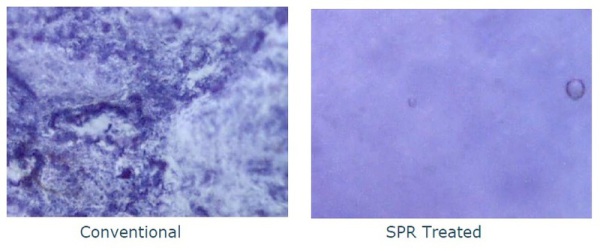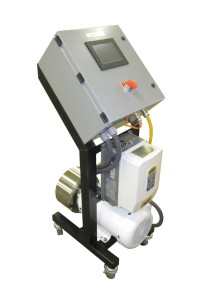Hydration in Fracking
SPR Hydration Benefits
- True continuous "dry on the fly" hydration
- Complete hydration with no "fish eyes"
- Hydrate using cold water
- Use less gum powder for same target viscosity
- Reduced cost and environmental impact
Viscosity Increasing agents, when mixed with a working fluid, function to increase or otherwise affect the viscosity or flow characteristics of the fluid so that the fluid is better suited for an intended use. Fracking companies use large amounts of viscosifiers during the creation of a new well. When preparing drilling mud for use in oil drilling operations, a specific viscosity of the mud is desired to cool and lubricate the drill head assembly and carry away cuttings.
Gum hydration can be a very finicky process. If the gum is not hydrated properly, “gel balls” or “fish eyes” will form and wreak havoc with downstream processes like pumps. In order to avoid these issues and meet quality specifications typically these viscosifiers were shipped to site already in dilute water solutions, suspended in oils. These solutions created both immense transportation costs as well as environmental concerns. These issues have served as a catalyst for companies to look for ways to hydrate gum at the well site from dry powder, often referred to as "dry on the fly" technology.
"Dry on the fly" has not been without issue. Coventional equipment often struggles to achieve complete hydration without the damaging "fish eyes" characteristic of incomplete hydration. To assist with the hydration at the well site, the fracking companies started using hot water at a cost of $2-$3 per barrel (42 gallons) of water adding cost, complexity and environmental impact to the process.
The Shockwave Power reactor (SPR), however, can be used to eliminate all of the conventional hydration problems at the well site. The cavitational action within the SPR easily separates the powder molecules from each other and allows water to fully encapsulate each polymer chain. Additionally, the pressure fluctuations push the water into the polymer, removing the need for hot water. In fact, the SPR can be used to hydrate polymer in water as cold as 33°F.
Hydro Dynamics is currently working with several companies to develop a “dry on the fly” mobile hydration trailer that will allow fracking companies to ship dry polymer to the well site and hydrate only what they need, when they need it, using water collected from the ground or nearby ponds without heating. These new systems will have the capability to hydrate natural or synthetic (or a blend) polymers at the proper concentrations for well use, as well as making a concentrated solution for future dilution.
The SPR Hydration Process
Conventional technologies for hydrating polymers to produce viscosifiers generally include mixing powdered polymer with water in a bulk mixer and then allowing the mixture to age before being added to a fluid to be viscosified. Traditional mixers used for this process often expose the polymer molecules to high shear stresses, which can damage and break apart a significant portion of the polymer molecule chains. To address this problem, traditional polymer hydrators often attempt reduce polymer chain damage by using elevated temperatures, mixing more slowly for long periods of time, adding secondary solvents to the mixture, or simply adding excess polymer to make up for damage and consequent incomplete hydration.
The SPR utilizes the power of cavitation shockwaves to induce microscopic and macroscopic pressure fluctuations within the mixture, while maintaining a low shear environment. The shockwaves and pressure fluctuations first separate and disperse individual particles of powder within the mixture allowing water to contact the powder particles on all sides. This maximizes the surface contact area between the water molecules and polymer chains. As the polymer chains in the particles begin to hydrate with water, the pressure fluctuations drive the water molecules into and out of the particles. This, in turn, detangles, releases, separates, and straightens the individual polymer molecule chains found in each particle of the powder. The cavitation induced pressure fluctuations serve to straighten, untangle, and stretch the polymer chains more fully, resulting in more complete hydration and viscosity development when compared to conventional shear mixing. The result is a greatly improved completeness of hydration with minimal damage to the resulting hydrated polymer chains.
Results
Using the ShockWave Power reactor in the lab have shown an increase in hydration yield of 20-30% over traditional hydration techniques. The contact time between particles of powder and the energy applied (which is directly proportional to the rotation rate of the rotor) has proven to be a critical factor. The ShockWave Power reactor can be controlled precisely and easily to establish and maintain virtually any dwell time and energy input for maximizing the hydration process, which makes the SPR the ideal hydration system.
Using the microscopic and macroscopic pressure fluctuations of cavitation within the SPR allows for many benefits in hydration. Some of these benefits include:
- Cost reduction and/or increased viscosity due to higher hydration yield
- Elimination or reduction of the need for costly secondary solvents
- Reduced temperatures required for complete hydration
- Less shear damage due to the low shear environment of the cavitation zone
- Improved homogeneity and thus quality of the final product






